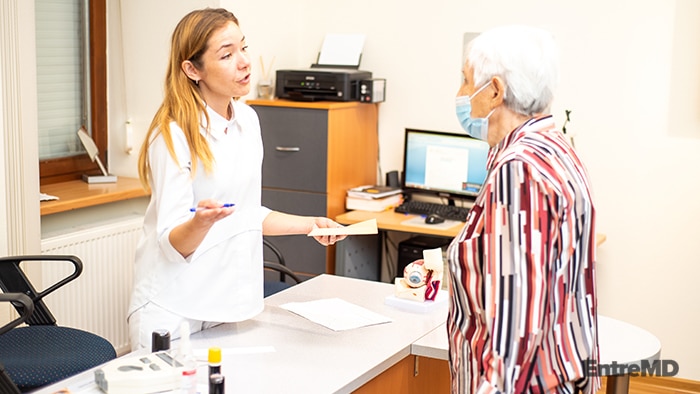We’ve all heard the term “The Great Resignation.” In May of last year, Texas A&M University organizational psychologist Anthony Klotz cited COVID-19 as causing workers to consider whether their jobs made them happy or gave them a sense of purpose. He called it the “pandemic epiphany.”
I’m fairly certain that while this may be the big picture reason for why many doctors are quitting their jobs, the more specific reasons have little to do with theoretical questions like am “Am I happy enough, or do I feel my work gives me purpose?”
CHG Healthcare, an American physician staffing company, headlined a recent article with the startling title, Nearly Half of Physicians Changed Jobs During the Pandemic. While their survey of more than 500 physicians said that only 3% left medicine altogether to work in a non-clinical field and 8% retired, a whopping 43% of physicians quit their current jobs to find something else.
The survey dug into how much impact the pandemic had on their decisions. Whether a doctor changed careers, retired, or left the medical field, their decisions were “very or extremely” influenced by COVID-19.
Another important survey by Elsevier called The Clinician of the Future, Report 2022, asked respondents whether they were planning to leave their current role within two or three years. Almost one-third (31%) said they were.
The survey noted a significant difference in the responses across the globe. Only 14% of doctors in China planned to leave, while numbers in the US, the UK, and Germany were 47% and 48%.
While 43% of doctors who took the CHG Healthcare survey said they would stay in healthcare, the global survey by Elsevier noted that 39% planned to leave the profession. Twenty-one percent planned to retire, 13% planned to move to a non-healthcare-related job, and 5% planned to “do something else.”
Physician Burnout
Even before the pandemic, burnout was a major issue for physicians across the US. A well-known study released in December of 2021 evaluated the relationships between COVID-19 and the increased burnout doctors are experiencing.
Over 20,000 healthcare workers were surveyed, and the significantly higher levels of burnout were directly linked to approximately one-third of physicians intending to cut down on their work hours, if not quitting altogether.

The study’s lead author, Christine A. Sinsky, MD, said:
“While we anticipated that the stress of the pandemic would impact the people providing care, the extent of stress and the percentage of workers considering leaving is worrisome.
Our study demonstrates that the US healthcare workforce is in peril. If even one-third to one-half of nurses and physicians express their intentions to cut back or leave, we won’t have enough staff to meet the needs of patients.”
Burnout as a reaction to long-term stress has reached epidemic proportions and seems to be the overarching reason doctors are quitting their jobs. Burnout symptoms include emotional exhaustion, reduced empathy towards patients, and deep feelings of “decreased personal achievement.”
Merritt Hawkins found that 19% of final-year residents would choose a different career path if they could start over. They see doctors they respect and have been practicing medicine for years struggling with burnout and don’t want to go down that same path.
While burnout affects all specialties and practice settings, a number of specific issues trigger why a doctor would decide to leave their clinical practice.
Five Reasons Why Doctors Are Quitting Their Jobs
1 — They want a better work/life balance
Far and away, the number one motivator for physicians quitting their job was a desire for a better work/life balance. This has been a primary motivator since 2018, but in 2022 the number of doctors who prioritized a work/life balance jumped from 63% to 85%.
Research shows that one in four doctors work 61-80 hours weekly, while the rest work an average of 51.4 hours weekly. The Prospective Doctor finds that many doctors work at least 80 hours weekly, if not more.

Pajama time is a fairly new concept that’s come into play. The term refers to the hours doctors spend at home as they catch up on documentation and “paperwork” they simply couldn’t get to during their day.
It’s unclear whether this extra pajama time is accounted for in the average 51.4 hours of time doctors work or is on top of those hours. What is clear is that working at home, even in your pajamas, doesn’t contribute to a better work/life balance.
As a millennial, Dr. Arun Saini can say that most physicians see the damage burnout and a poor work/life balance have done to their colleagues and want to avoid going down the same path. He cites an AMA survey that says 92% of doctors under 35 felt that work/life balance was important.
2 — They spend too much time on administrative tasks
Since the advent of electronic health records (EHRs), nearly a third of doctors have reported spending 20 hours or more weekly on paperwork and “administrative costs.” Medscape compiled the report, and its authors described the time physicians spend on these tasks as “mind-boggling.”
Used by close to 90% of office-based doctors, electronic health records have been linked to experiencing a greater administrative burden, linked to “lower career satisfaction.” Although it was intended to streamline the sharing of data documents, it hasn’t turned out that way.
In the third quarter of 2020, Medical Economics conducted a survey to determine what doctors would say they expect the most challenging issues they would face in the rest of the year. Many listed “paperwork” as their “chief complaint.”

Apparently, the time doctors can now afford to give to seeing patients looks like this:
- 5% More than 65 hours
- 9% 56-65 hours
- 14% More than 30 hours
- 15% 46-55 hours
- 56% 30-45 hours
The Annals of Internal Medicine stated that “physicians in outpatient settings spent about 27% of their day on direct clinical face time with patients, but 49% on EHRs and desk work.”
Welcome to an average of two hours a day of medical “pajama time.”
Another survey from the American Medical Association found that 86% of survey takers felt the administrative burden of prior authorizations from payers is “high or extremely high.” Consuming more than 16 hours a week.
The same survey reported that 31% of doctors blamed paperwork more than any other single factor for their feelings of burnout. This led to a rate of double the number of doctors who felt that a poor work/life balance contributed to their burnout.
3 — They don’t feel supported by their administration
It’s no secret that healthcare changes rapidly, and keeping up with the shifting whirlwind is hard. “The relationship between those who deliver care and those who administrate it has never been tenser, challenged, or fractured,” and it boils down to this: physicians and administrators don’t trust each other.

The same CHG Healthcare survey I referenced earlier in this article reported that doctors who were unhappy with their “administration’s response to the pandemic” listed their issues as:
- 42% poor leadership
- 34% lack of overall employer support
- 27% insufficient staffing levels
Most doctors have experienced or, at some point, will experience a difficult relationship with their healthcare facility’s administrative staff. It’s rare when the two conflicting agendas in healthcare — patient care versus the financial bottom line – aren’t clashing.
Often, those in the administration have alpha personalities. This makes them extremely good at their job but doesn’t necessarily make them easy to get along with. Getting the job done is often more important than caring for the well-being of the staff.
4 — They experience negative public attitudes
Remember the days at the beginning of the pandemic when the public thought we were their heroes? According to the JAMA Health Forum study, “The cheers have gone away” while misinformation has flourished and front-line health workers are taking the brunt of the public’s reaction.
Some doctors report being cyberbullied, harassed, or threatened when they try to counter misinformation about vaccination or ways to stop the spread of this infectious disease. And patients aren’t only being difficult around COVID-19 issues.

According to some reports, doctors are finding one in six patients difficult. “Admitted or not,” James E. Groves, author and psychiatrist writes, “the fact remains that a few patients kindle aversion, fear, despair or even downright malice in their doctors.”
The authors of “Managing Difficult Interactions with Patients in Neurology Practices, describe difficult patients as “Low-level torture (death by a million little cuts). They may order the doctor to perform diagnostic tests, prescribe medications, or make referrals, none of which are medically necessary.”
What is even harder to hear is that social media and news sites give the public the sense that doctors don’t listen and don’t care. Every doctor I know takes their work seriously and works as hard as possible to care for their patients.
5 — They’re struggling financially
While it’s “common knowledge” that doctors are rich and have a swimming pool in their backyard, the truth is somewhat more nuanced. Yes, doctors can be “rich” depending on their specialty or sub-specialty, but there are many who aren’t in a position to flourish financially.
The average salary of a resident doctor in 2022 is $65,302, according to Glassdoor. While many medical school graduates are thankful that they can postpone paying back their student loans until after finishing their residency, there’s a good reason not to, as you’ll start occurring interest as soon as you’ve graduated.

Ashley Chorath and Andrew Tiu are a newly married couple who are both resident doctors. They know many residents who are “paying $200,000, $300,000 and $400,000 of student debt back on [a] $50,000 or $60,000 dollar salary.” Between monthly bills and student loans, their debt weighs heavily on both of them.
Once you’ve finished your residency, your income will increase significantly to somewhere between $320,000 and $385,000 annually. But if you want to own part or all of a practice, you’ll be spending between one-third and one-half of your revenue on overhead. Estimates suggest that setting up a practice costs between $70,000 and $100,000.
And then there’s the fear of being sued if something goes wrong. Malpractice insurance can cost an average of $7,500 per year. This works out to about 3.2% of most physicians’ incomes.
Trends for Change
Back to The Clinician of the Future, Report 2022. It doesn’t just publish its survey’s details (31% of front-line healthcare workers are planning to leave their current role by 2025). The 116-page report goes on to outline what nearly 3,000 practicing doctors and nurses worldwide shared and what they and healthcare as a whole need.
The tone of the report is both optimistic and hopeful.
“In this report, you will gain meaningful insights from thousands of doctors and nurses around the world, as well as experts and key opinion leaders in the USA, UK, and China. They have shared with us the many changes impacting their work and the key areas that they require greater support and advancement in, among them data analytics, digital health technologies, and improving empathy and communications with patients. We thank them sincerely for participating in this study and sharing their invaluable perspectives.”
In five well-defined sections, the report outlines a “path to a fundamental shift away from focusing on illness towards a total health, patient-centered, digital approach to well-being.” These five sections outline different possible paths for the future of the healthcare professional. Paths that don’t involve quitting the field entirely but rather evolving with it as society and the outlook of healthcare change.

I hope that these outcomes serve to more fully support the doctors and nurses working in healthcare and that they will create an environment that will attract the next generation of healthcare workers. One who feels as passionately as we do about caring for those who need us.
If you are a doctor who is considering quitting the field of medicine, I truly wish you the best of luck in your future endeavors, no matter what they may be.
I’d love to hear what all of you think about today’s topic and what you think the future may look like for the medical field. Are you feeling optimistic about the future for doctors? Or, perhaps, do you have a little more of a pessimistic outlook? Feel free to drop me a line whenever you have the opportunity, and we’ll get a conversation going. Maybe for the more pessimistic folks out there, I can try to show you how bright the future for doctors could possibly be.


